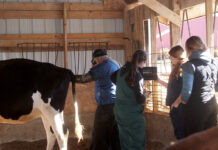Since you speak English as well as anyone, perhaps you understand the working paragraph of a May 19 Washington Post column that explains the trading strategy employed by JP Morgan Chase & Co. to, ah, hedge its market risk.
It reads: “It is this exemption that would allow (J.P. Morgan executive, Ina) Drew and her team to hedge the credit on the bank’s unusually large portfolio of corporate bonds by purchasing a ‘synthetic’ derivatives instrument whose value would go up when a widely-traded index of more than 120-blue-chip corporate bonds went down — or vice versa. But it was also broad enough that it would make it possible for them to later hedge their original hedge and move aggressively to take the other side of the bet.”
See what I mean?
Three “hedges,” a “vice versa” and “a ‘synthetic’ derivatives instrument” and I’m a puddle of muddle. You want to take a guess?
What is quite clear, however, is that Morgan’s so-called hedge wasn’t a hedge that any farmer or rancher — here or anywhere — would recognize.
There wasn’t one kernel of corn or one thread of honesty underlying it. Pure and simple, it was a naked bet, raw speculation, and hedges, by definition in any language, are exactly the opposite.
Gamble
The Post article (link to it and other documents at www.farmandfoodfile.com) was one the few pieces of journalism to recognize this difference and to call this fat slab of pork a pig: “It all has very little to do with hedging and a lot to do with gambling.”
By pure coincidence, just as the Morgan mess was again wobbling both the global financial markets and the knees of Washington regulators, the futures market — the place where actual hedges are placed — was again expanding its trading hours.
On May 20, trading in the CME Groups’ key ag contracts moved to 21 hours per day, from 5 p.m. one day until 2 p.m., Central Time, the following day. The expanded hours, explains the CME, will give market “customers … greater access to the unparalleled liquidity, depth and product choice of CBOT,” the old Chicago Board of Trade, “Grain, Oilseed and ethanol futures and options markets …”
Impact on markets
It also will give farmers and ranchers unparalleled heartburn on days when key USDA acreage, production, storage and livestock reports are released because markets impacted by the reports will be trading as the numbers are made known.
As such, the very markets that are meant to protect producers from being burned by volatility could become instant bonfires and — what’s wrong with this picture? — the government will be bringing the gasoline.
Facing enormous risks on report days, country elevators, ethanol plants and other grain market participants are expected to either widen the basis, the gap, between futures and cash prices to limit market exposure or just stop buying grain until the market “trades” the report and establishes a more firm view of price.
Response
Worse yet, none of this is about making markets more efficient or price discovery more transparent. Indeed, the hours of the Chicago ag markets were expanded as a competitive response to the threat of another commodity exchange, the Intercontinental (which loves to be known as the ICE; get it, ICE?), that announced in April it would begin trading ags in May.
So, less than four years and nearly $500 billion of taxpayer money to save the banking system from the bankers, six months after MF Global torched commodity markets, farmers and ranchers for $1.5 billion in an implosive bankruptcy and a month after Morgan admitted it fell into a black hole of its own making, commodity markets are now offering “unparalleled liquidity, depth and product choice.”
Gee, I wonder how that’s going to turn out.













